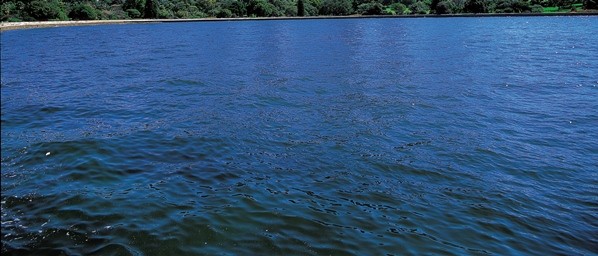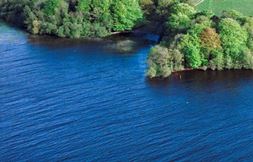 A new study from the Indiana Chamber of Commerce Foundation warns that without planning and proper management, the state’s water supply – a longtime natural resource strength – could become a challenge for both businesses and citizens.
A new study from the Indiana Chamber of Commerce Foundation warns that without planning and proper management, the state’s water supply – a longtime natural resource strength – could become a challenge for both businesses and citizens.
While Indiana is not facing the dramatic shortages of California or other states in the West and Southwest, its current economic advantage – plentiful water supplies – will dry up, according to Water and Economic Development in Indiana: Modernizing the State’s Approach to a Critical Resource.
“This is definitely a jobs and economic development issue,” says Indiana Chamber President and CEO Kevin Brinegar. “Our state’s economy is growing more diverse, but we always will make things. And it often takes large, reliable supplies of water to do so.
“We experienced a seasonal drought just two years ago and at previous times in our state’s history. The goal is to ensure those droughts and more prolonged shortages do not negatively impact our state in the future,” he explains.
The importance of this issue is underscored in the Indiana Chamber-led Indiana Vision 2025 economic development action plan, which lists the development and implementation of a state water strategy as one of its 33 goals. What’s more, a recent report out of Michigan found that Indiana is the most water-dependent state in the entire country as it pertains to its impact on the economy.
The Indiana Chamber study was commissioned in late 2013 and conducted over the first half of this year. It was led by Bloomington-based Jack Wittman, Ph.D., principal geoscientist with INTERA Incorporated; Wittman has frequently consulted with water providers throughout the state. A water advisory council, comprised of key water users and producers, provided insight and guidance through a series of regular meetings.
Among the findings:
• In Southern Indiana, local water resources are not always able to meet anticipated future needs. For example, there are few aquifers or perennial streams immediately south of Bloomington – a prime area for business development with the expansion of Interstate 69 and the continued work at the Crane Division of the Naval Surface Warfare Center.
• While water supplies in Central Indiana are diverse and utilities are making plans, continued population growth leads to projections of an additional 50 million gallons per day to meet the needs of the region by 2050.
• North of the Wabash River, water is relatively abundant. The area, however, is seeing significant increases in water usage for irrigation. These seasonal fluctuations require additional monitoring, in part to determine impact on other water users.
“Not only does water matter today,” according to Wittman, “but management of water will be even more essential in the future.”
Wittman says a separate study conducted earlier this year found that Indiana ranks first in the nation in the percentage of its economy that depends on water. He also notes various agencies (state, federal and local) and universities already do work in the areas of water management and analysis, but that one entity must be designated to lead the way. Among the specific recommendations:
• Creating widespread awareness about the need for water supply planning
• Coordinating current efforts, including the funding of additional water research
• More robust monitoring of water resources
• Standardized systems for data analysis and water resource management
“What this study does is set the stage for creation of a long-needed, long-range water plan for the state,” offers Vince Griffin, Indiana Chamber vice president of energy and environmental policy. “While a credible plan may take three to five years, legislators – from the Senate and House, as well as both parties – understand the importance of this issue and are prepared to lead on the next steps.”
Brinegar adds, “Additional financial investments will be needed to ensure a reliable water future. That’s why we commissioned this study now and why we encourage all involved to take these results and use them as a playbook for development of a long-range water plan.
“Indiana should be taking advantage of its current water supplies to help attract and retain businesses – and jobs. If we plan properly for the future, those resources will continue to be an economic advantage.”
Additional comments from four members of the water advisory council:
“The release of this study is a good first step in starting the important dialogue about water use in our state. Even though agriculture is a small user compared to other sectors, a stable and abundant water supply is crucial to growing the crops and livestock that feed Hoosier families. Indiana Farm Bureau looks forward to continuing our participation in this important project that will ensure an adequate water supply for all of Indiana.”
– Don Villwock, president of Indiana Farm Bureau
“This report, and the efforts of the (Indiana) Chamber’s Water Advisory Council, are a call to action for Indiana to prepare for meeting the broad range of water needs that form the foundation of the economic future and quality of life for all Hoosiers. By improving the understanding of our current water resources, we can be better prepared to assure their continued availability for the state’s businesses and residents.”
– Thomas M. Bruns, president, Aqua Indiana, Inc. and representing the Indiana Chapter of the National Association of Water Companies
“Indiana corn and soybean growers realize that water is a critical resource needed to produce our crops and for our industry to flourish. This report gives us all a starting point to ensure that our state thrives while our farmers continue to provide food for their families, neighbors and the world.”
– Mike Dunn, director of production research, Indiana Soybean Alliance and Indiana Corn Marketing Council
“The Indiana Section of the American Water Works Association believes this study is an important step toward ensuring an uninterrupted supply of water for Indiana. The availability of water is vital to the continued growth of business and industry and to the quality of life for all Hoosiers. Congratulations to the Indiana Chamber Foundation on its foresight in taking a long-term approach to addressing the importance of water to Indiana’s future.”
– John A. Hardwick, chair, Water Utility Council, Indiana Section American Water Works Association


 Indiana’s water quantity issue received significant attention in the 2016 Indiana legislative session as Sen. Charbonneau continues to champion calculated steps toward a credible water policy for the state. His mantra has been “data before decisions” and the legislation this year reflects that refrain, which the Indiana Chamber strongly supports.
Indiana’s water quantity issue received significant attention in the 2016 Indiana legislative session as Sen. Charbonneau continues to champion calculated steps toward a credible water policy for the state. His mantra has been “data before decisions” and the legislation this year reflects that refrain, which the Indiana Chamber strongly supports. A new study from the Indiana Chamber of Commerce Foundation warns that without planning and proper management, the state’s water supply – a longtime natural resource strength – could become a challenge for both businesses and citizens.
A new study from the Indiana Chamber of Commerce Foundation warns that without planning and proper management, the state’s water supply – a longtime natural resource strength – could become a challenge for both businesses and citizens. Many involved in the Indiana environmental community are likely aware of our ongoing work on a survey of Indiana water resources in an effort to gauge future supply and demand.The Chamber actually hired Bloomington-based hydrogeologist Jack Wittman for the effort. In fact, read his recent Q & A with Indy-based
Many involved in the Indiana environmental community are likely aware of our ongoing work on a survey of Indiana water resources in an effort to gauge future supply and demand.The Chamber actually hired Bloomington-based hydrogeologist Jack Wittman for the effort. In fact, read his recent Q & A with Indy-based  (The following column from Vince Griffin, our VP of environment and energy, appeared in the
(The following column from Vince Griffin, our VP of environment and energy, appeared in the  We've discussed battles over water rights previously — and certainly will again. Last week, the U.S. Supreme Court basically told Texas it has no right to claim billions of gallons of water on the Oklahoma side of the Red River. The Court reinforced an existing compact between those two states, Arkansas and Louisiana.
We've discussed battles over water rights previously — and certainly will again. Last week, the U.S. Supreme Court basically told Texas it has no right to claim billions of gallons of water on the Oklahoma side of the Red River. The Court reinforced an existing compact between those two states, Arkansas and Louisiana.  Like many states, Indiana wrestles with water supply issues and a viable statewide plan is desperately needed. However, our situation is not nearly as dire as it is for Nevada. Stateline documents how a water pact between Nevada and Utah, which was mandated in 2004 and tentatively agreed to in 2009, has now washed down the drain as Utah's governor poured cold water on the deal (so many water puns).
Like many states, Indiana wrestles with water supply issues and a viable statewide plan is desperately needed. However, our situation is not nearly as dire as it is for Nevada. Stateline documents how a water pact between Nevada and Utah, which was mandated in 2004 and tentatively agreed to in 2009, has now washed down the drain as Utah's governor poured cold water on the deal (so many water puns).
